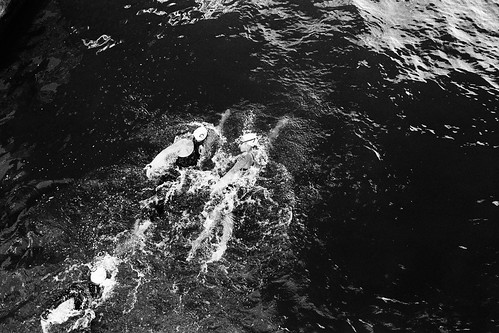Cose 6-phosphate dehydrogenase (G6PDH) was employed as the purchase AKT inhibitor 2 cycling enzyme. A final concentration of 0.2 unit/ml G6PDH was used. A list of all the required reagents, with their supplier catalog numbers, is provided as Table S2.Plate Reader SettingsWhen using PES and MTT as detection dyes, the plate reader should be set to measure absorbance at 570 nm. When using PMS and resorufin, a plate reader capable of taking fluorescence reading was configured such that the excitation wavelength was 540 nm and emission 1676428 wavelength was 586 nm. Kinetic curves are recorded for the first 5 to 10 minutes. In theory, one should be taking the initial rate of reaction. We however took data points from 60 s to 300 s and calculated average reaction velocity (Vmean) as often the enzyme requires a short period to become most active. We used SpectraMax Plus and SpectraMax M5 96-well plate readers from Molecular Devices (Sunnyvale, California, U.S.) for absorbance and fluorescence assays respectively. The reading interval is largely instrument dependent but is also affected by the number of samples. We always choose the shortest possible interval (no longer than 10 s). Readings were all performed at temperature about 37uC.Plate Assay ProtocolThe NAD+ standard curve was made by 2-fold serial dilution using homogenization buffer starting from 100 mM. 5 ml of NAD+ standard or sample were added to each well containing 120 ml of reaction mixture without PES and MTT, which were added to start the reaction right before the plate was read. After adding the dyes, dehydrogenase was added into the reaction mixture and reading started. Adding PES only shortly before reading wasMeasuring Redox Ratio by a Coupled Cycling Assayproposed by Umemura and Kimura [23] as an approach to minimize background noise. The blank control assay contained reaction mixture and 5 ml of homogenization buffer only. A standard curve was generated by plotting the concentrations of standards against Vmean and the concentrations of unknown samples were calculated from interpolation.Triacylglyceride, Glycogen, Glucose and Soluble Protein QuantificationHomogenates not treated with phenol-chloroform were used for these assays. Triacylglyceride was assayed using glycerol phosphate Oltipraz cost oxidase (GPO) based method (InfinityTM Triglycerides reagent, Thermo Scientific). Glycogen and glucose were assayed using glucose oxidase based method (InfinityTM Glucose reagent, Thermo Scientific). Glycogen was converted to glucose using amyloglucosidase (Roche Diagnostics) and was subsequently assayed. Soluble protein concentration was determined using BCA Protein Assay Reagent (Thermo Scientific Pierce).reaction velocity and improves the linearity of standard curve (Fig. 1b, 2c and 2e). It is possible to use less ADH in the NADx assay when it is coupled with Wolff ishner reduction. Assaying 25 mM NAD+ with 80, 120, 160  and 200 mg/ml ADH, we found ADH concentration (mg/ml) and Vmean to have a weak and only marginally significant relationship
and 200 mg/ml ADH, we found ADH concentration (mg/ml) and Vmean to have a weak and only marginally significant relationship  (Vmean = 379+0.558[ADH], p = 0.047, n = 8).65uC Incubation for 30 Minutes is not Sufficient to Fully Degrade NAD+Thirty minutes of 65uC incubation was shown to degrade NAD+ while keeping NADH intact [24], as NAD+ has a higher temperature dependent degradation rate than NADH at pH around 7.0 [24]. We find such a treatment is not sufficient for Drosophila homogenate and additional 0.01 M OH2 is required in order to fully decompose NAD+. NAD+ standard solutions of 25, 12.5, 6.25 and 3.125 mM.Cose 6-phosphate dehydrogenase (G6PDH) was employed as the cycling enzyme. A final concentration of 0.2 unit/ml G6PDH was used. A list of all the required reagents, with their supplier catalog numbers, is provided as Table S2.Plate Reader SettingsWhen using PES and MTT as detection dyes, the plate reader should be set to measure absorbance at 570 nm. When using PMS and resorufin, a plate reader capable of taking fluorescence reading was configured such that the excitation wavelength was 540 nm and emission 1676428 wavelength was 586 nm. Kinetic curves are recorded for the first 5 to 10 minutes. In theory, one should be taking the initial rate of reaction. We however took data points from 60 s to 300 s and calculated average reaction velocity (Vmean) as often the enzyme requires a short period to become most active. We used SpectraMax Plus and SpectraMax M5 96-well plate readers from Molecular Devices (Sunnyvale, California, U.S.) for absorbance and fluorescence assays respectively. The reading interval is largely instrument dependent but is also affected by the number of samples. We always choose the shortest possible interval (no longer than 10 s). Readings were all performed at temperature about 37uC.Plate Assay ProtocolThe NAD+ standard curve was made by 2-fold serial dilution using homogenization buffer starting from 100 mM. 5 ml of NAD+ standard or sample were added to each well containing 120 ml of reaction mixture without PES and MTT, which were added to start the reaction right before the plate was read. After adding the dyes, dehydrogenase was added into the reaction mixture and reading started. Adding PES only shortly before reading wasMeasuring Redox Ratio by a Coupled Cycling Assayproposed by Umemura and Kimura [23] as an approach to minimize background noise. The blank control assay contained reaction mixture and 5 ml of homogenization buffer only. A standard curve was generated by plotting the concentrations of standards against Vmean and the concentrations of unknown samples were calculated from interpolation.Triacylglyceride, Glycogen, Glucose and Soluble Protein QuantificationHomogenates not treated with phenol-chloroform were used for these assays. Triacylglyceride was assayed using glycerol phosphate oxidase (GPO) based method (InfinityTM Triglycerides reagent, Thermo Scientific). Glycogen and glucose were assayed using glucose oxidase based method (InfinityTM Glucose reagent, Thermo Scientific). Glycogen was converted to glucose using amyloglucosidase (Roche Diagnostics) and was subsequently assayed. Soluble protein concentration was determined using BCA Protein Assay Reagent (Thermo Scientific Pierce).reaction velocity and improves the linearity of standard curve (Fig. 1b, 2c and 2e). It is possible to use less ADH in the NADx assay when it is coupled with Wolff ishner reduction. Assaying 25 mM NAD+ with 80, 120, 160 and 200 mg/ml ADH, we found ADH concentration (mg/ml) and Vmean to have a weak and only marginally significant relationship (Vmean = 379+0.558[ADH], p = 0.047, n = 8).65uC Incubation for 30 Minutes is not Sufficient to Fully Degrade NAD+Thirty minutes of 65uC incubation was shown to degrade NAD+ while keeping NADH intact [24], as NAD+ has a higher temperature dependent degradation rate than NADH at pH around 7.0 [24]. We find such a treatment is not sufficient for Drosophila homogenate and additional 0.01 M OH2 is required in order to fully decompose NAD+. NAD+ standard solutions of 25, 12.5, 6.25 and 3.125 mM.
(Vmean = 379+0.558[ADH], p = 0.047, n = 8).65uC Incubation for 30 Minutes is not Sufficient to Fully Degrade NAD+Thirty minutes of 65uC incubation was shown to degrade NAD+ while keeping NADH intact [24], as NAD+ has a higher temperature dependent degradation rate than NADH at pH around 7.0 [24]. We find such a treatment is not sufficient for Drosophila homogenate and additional 0.01 M OH2 is required in order to fully decompose NAD+. NAD+ standard solutions of 25, 12.5, 6.25 and 3.125 mM.Cose 6-phosphate dehydrogenase (G6PDH) was employed as the cycling enzyme. A final concentration of 0.2 unit/ml G6PDH was used. A list of all the required reagents, with their supplier catalog numbers, is provided as Table S2.Plate Reader SettingsWhen using PES and MTT as detection dyes, the plate reader should be set to measure absorbance at 570 nm. When using PMS and resorufin, a plate reader capable of taking fluorescence reading was configured such that the excitation wavelength was 540 nm and emission 1676428 wavelength was 586 nm. Kinetic curves are recorded for the first 5 to 10 minutes. In theory, one should be taking the initial rate of reaction. We however took data points from 60 s to 300 s and calculated average reaction velocity (Vmean) as often the enzyme requires a short period to become most active. We used SpectraMax Plus and SpectraMax M5 96-well plate readers from Molecular Devices (Sunnyvale, California, U.S.) for absorbance and fluorescence assays respectively. The reading interval is largely instrument dependent but is also affected by the number of samples. We always choose the shortest possible interval (no longer than 10 s). Readings were all performed at temperature about 37uC.Plate Assay ProtocolThe NAD+ standard curve was made by 2-fold serial dilution using homogenization buffer starting from 100 mM. 5 ml of NAD+ standard or sample were added to each well containing 120 ml of reaction mixture without PES and MTT, which were added to start the reaction right before the plate was read. After adding the dyes, dehydrogenase was added into the reaction mixture and reading started. Adding PES only shortly before reading wasMeasuring Redox Ratio by a Coupled Cycling Assayproposed by Umemura and Kimura [23] as an approach to minimize background noise. The blank control assay contained reaction mixture and 5 ml of homogenization buffer only. A standard curve was generated by plotting the concentrations of standards against Vmean and the concentrations of unknown samples were calculated from interpolation.Triacylglyceride, Glycogen, Glucose and Soluble Protein QuantificationHomogenates not treated with phenol-chloroform were used for these assays. Triacylglyceride was assayed using glycerol phosphate oxidase (GPO) based method (InfinityTM Triglycerides reagent, Thermo Scientific). Glycogen and glucose were assayed using glucose oxidase based method (InfinityTM Glucose reagent, Thermo Scientific). Glycogen was converted to glucose using amyloglucosidase (Roche Diagnostics) and was subsequently assayed. Soluble protein concentration was determined using BCA Protein Assay Reagent (Thermo Scientific Pierce).reaction velocity and improves the linearity of standard curve (Fig. 1b, 2c and 2e). It is possible to use less ADH in the NADx assay when it is coupled with Wolff ishner reduction. Assaying 25 mM NAD+ with 80, 120, 160 and 200 mg/ml ADH, we found ADH concentration (mg/ml) and Vmean to have a weak and only marginally significant relationship (Vmean = 379+0.558[ADH], p = 0.047, n = 8).65uC Incubation for 30 Minutes is not Sufficient to Fully Degrade NAD+Thirty minutes of 65uC incubation was shown to degrade NAD+ while keeping NADH intact [24], as NAD+ has a higher temperature dependent degradation rate than NADH at pH around 7.0 [24]. We find such a treatment is not sufficient for Drosophila homogenate and additional 0.01 M OH2 is required in order to fully decompose NAD+. NAD+ standard solutions of 25, 12.5, 6.25 and 3.125 mM.
Posted inUncategorized
